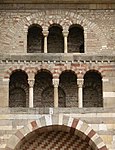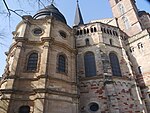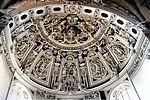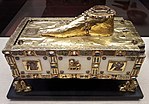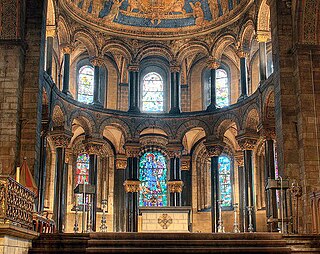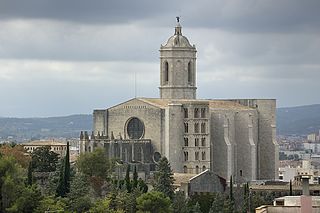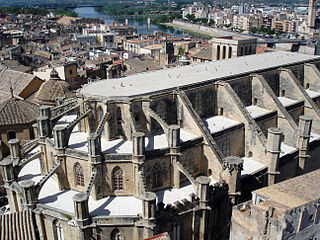| Cathedral of Trier | |
|---|---|
| High Cathedral of Saint Peter in Trier | |
 | |
| 49°45′22″N6°38′35″E / 49.75611°N 6.64306°E Coordinates: 49°45′22″N6°38′35″E / 49.75611°N 6.64306°E | |
| Location | Liebfrauenstraße 12 Trier, Rhineland-Palatinate |
| Country | Germany |
| Denomination | Roman Catholic |
| Website | www |
| History | |
| Status | Cathedral |
| Relics held | Holy Robe |
| Architecture | |
| Functional status | Active |
| Heritage designation | UNESCO World Heritage Site |
| Designated | 1986 |
| Style | Romanesque |
| Years built | c.270 (first building) |
| Groundbreaking | 1235 (current building) |
| Completed | 1270 |
| Specifications | |
| Materials | Roman brick |
| Administration | |
| Diocese | Trier |
| Province | Cologne |
| Clergy | |
| Bishop(s) | The Rt Revd Dr Stephan Ackermann [1] |
| Provost | Werner Rössel [2] |
The High Cathedral of Saint Peter in Trier (German : Hohe Domkirche St. Peter zu Trier), or Cathedral of Trier (German : Trierer Dom), is a Roman Catholic cathedral in Trier, Rhineland-Palatinate, Germany. It is the oldest church in Germany and the largest religious structure in Trier, notable for its long life span and grand design. The central part of the nave was built of Roman brick in the early fourth century, resulting in a cathedral that was added onto gradually in different eras. The imposing Romanesque westwork, with four towers and an additional apse, has been copied repeatedly. [3] The Trier Cathedral Treasury contains an important collection of Christian art. In 1986 the church was listed as a UNESCO World Heritage Site, as part of the Roman Monuments, Cathedral of St. Peter and Church of Our Lady in Trier.

German is a West Germanic language that is mainly spoken in Central Europe. It is the most widely spoken and official or co-official language in Germany, Austria, Switzerland, South Tyrol (Italy), the German-speaking Community of Belgium, and Liechtenstein. It is also one of the three official languages of Luxembourg and a co-official language in the Opole Voivodeship in Poland. The languages which are most similar to German are the other members of the West Germanic language branch: Afrikaans, Dutch, English, the Frisian languages, Low German/Low Saxon, Luxembourgish, and Yiddish. There are also strong similarities in vocabulary with Danish, Norwegian and Swedish, although those belong to the North Germanic group. German is the second most widely spoken Germanic language, after English.

A cathedral is a Christian church which contains the cathedra of a bishop, thus serving as the central church of a diocese, conference, or episcopate. The equivalent word in German for such a church is Dom ; see also Duomo in Italian, Dom(kerk) in Dutch, and cognates in many other European languages. Churches with the function of "cathedral" are usually specific to those Christian denominations with an episcopal hierarchy, such as the Catholic, Anglican, Orthodox, and some Lutheran and Methodist churches. Church buildings embodying the functions of a cathedral first appeared in Italy, Gaul, Spain and North Africa in the 4th century, but cathedrals did not become universal within the Western Catholic Church until the 12th century, by which time they had developed architectural forms, institutional structures and legal identities distinct from parish churches, monastic churches and episcopal residences.

Trier, formerly known in English as Treves and Triers, is a city in Germany on the banks of the Moselle. Trier lies in a valley between low vine-covered hills of red sandstone in the west of the state of Rhineland-Palatinate, near the border with Luxembourg and within the important Moselle wine region. The German philosopher and one of the founders of Marxism, Karl Marx was born in the city in 1818.










